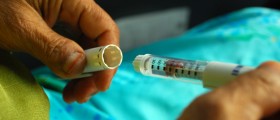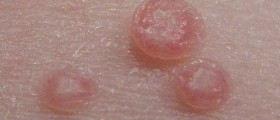
A xanthoma is a lump made of cholesterol. It develops under the skin (usually along the tendons). The very presence of xanthomas is a sign of high blood cholesterol. So these skin changes occur only in individuals who are suffering from high cholesterol.
Xanthomas Clinical Characteristics
Xanthomas may affect different parts of the body. However, they most frequently form around the inner or outer areas of the eyelids. A person may have one large xanthoma or several smaller ones. If these skin changes occur in clusters, the condition is known as xanthelasma. Apart from affecting the eyelids, xanthomas also form around joint (particularly the elbows and knees). They may additionally form in the creases of palms and fingers, on feet and buttocks. Tendonous xanthomas affect the Achilles tendon on the heel, tendons that are located at the back of the hands and arms.
The size of xanthomas varies a lot and they range from tiny little bumps to lumps which may be three inches in diameter.
Why do Xanthomas Develop?
As it has already been mentioned xanthomas only affect individuals suffering from high level or cholesterol in blood. The problem predominantly occurs in people with elevated low-density lipoprotein cholesterol (LDL-C). The level of this cholesterol is high because such individuals have a high-fat diet (generally accompanied by low-fiber diet). They are also obese and do not participate in any kind of physical activity.
Furthermore, xanthomas also affect people who are already suffering from certain medical conditions. For instance, they are frequent among diabetics, people suffering from inherited familiar hypercholesterolemia, hypothyroidism, some kidney disorders and certain liver problems. Xanthomas also occur in pregnant women as well as patients who are prescribed medications such as anti-seizure drugs, diuretics, steroids, Cyclosporine and retinoid drugs.
Xanthomas Treatment
Xanthomas cannot withdraw spontaneously. Therefore, the treatment must be invasive including surgery or some other ways which directly manipulate with cholesterol build-up and remove it.
Treatment may start with acetic acid. If it cannot remove the xanthoma, doctor can use electrical current (apply electrodessication) or opt for laser treatment. The last option is direct surgical approach and cutting the accumulated cholesterol. Which of the mentioned is going to be applied depends on the size of xanthomas, their number as well as the affected part of the body. The goal of the treatment is to remove xanthomas but not to cause any mutilation of the affected area.
Furthermore, it is essential to prevent recurrence of xanthomas. This is successfully achieved once the elevated cholesterol in blood is brought under control with dietary changes, regular physical activity and specific medications.

















Your thoughts on this
Loading...